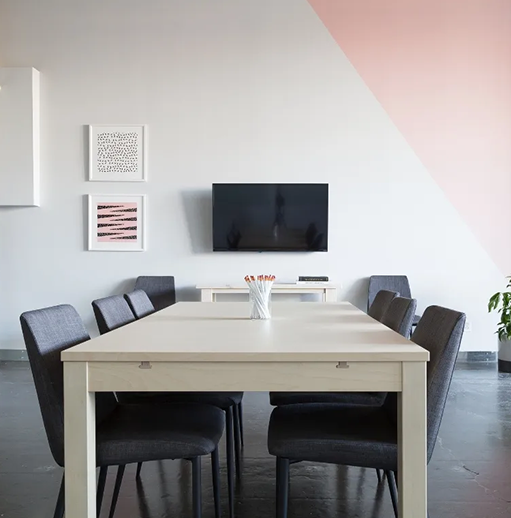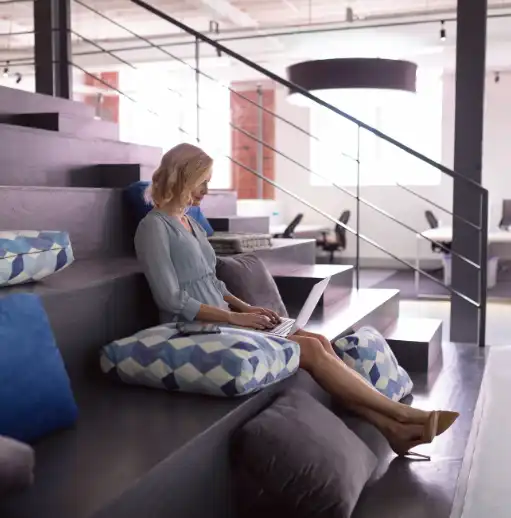
Time spent in the office has never been more precious. For employees on the hybrid work model, connecting with coworkers can be critical for overcoming the solitude of working from home. For employers, encouraging collaboration drives innovation and fosters a strong company culture, which helps with employee attraction and retention.
How important are connection and collaboration in the model office? According to Eptura’s Q3 Index Report, in a survey of 6,700 employees on workplace attitudes and behaviors, “socializing with friends and colleagues” and “collaborating with colleagues” were the top responses. So, the last thing you want is a meeting room booking system that wastes employees’ time onsite.
By implementing modern workplace management software, you can save everyone time and make more efficient use of your real estate portfolio.
How can a meeting room waste time?
Ask your employees if they feel like there is enough meeting space, and they’ll likely respond with an overwhelming “No.” But does the data match their opinion? The fact is many companies don’t know exactly how often and for how long employees are using the meeting rooms.
Even though people assume they don’t have enough meeting space, it’s more likely the actual problem is that they don’t have access to the right meeting spaces.
Legacy booking systems lack reliability, leading to inefficiencies. And it’s these time-killers that make employees feel there’s not enough space for them.
Here’s how a disconnect between opinion and data can happens:
- Departments that often meet are located on different floors or even in separate buildings.
- Large meeting rooms rarely hit capacity.
- Only some conference rooms have certain amenities, for example whiteboards and overhead projectors, but employees need them at every meeting.
- Meetings include video participants, but the room is booked for the total number of attendees, not the number of people physically present.
- The closest conference room doesn’t match a team’s typical meeting size.
- Meetings where no one shows up tie up rooms because no one cancels recurring meetings.
- Meeting rooms are perceived to belong to a certain department or floor.
- Only managers and above can reserve rooms, adding extra steps to the process.
- People get comfortable booking what they know, not what’s the most efficient room size for the specific meeting.
- There’s no incentive to match the size of the room with the number of people.
And sometimes it’s the smallest thing that affects which conference rooms are popular. Details like fabric or leather chairs, new whiteboards, a fun wall color, or even a window may not seem like amenities to you, but they can make a difference to employees.
Because so many meetings now include participants calling in over video, something as simple as good window curtains to decrease screen glare can make or break a room’s popularity.
5 ways to save time and space in your office
Once you’ve pinpointed sources of meeting inefficiency, it’s time to act. It’s important for meeting rooms to align with not only when and where employees meet, but also how they gather.
1. Relocate entire departments
Seems like a radical step, but there are situations where it’s the easiest solution.
Not all your departments are going to meet the same number of times a week in the same numbers. The marketing team might have a weekly all-hands catch-up / planning session, while the dev team prefers their morning Agile-inspired stand-up. The accounting team might have more meetings in a week than any other department, but only in relatively small groups.
Once you know the trends, you can look at opportunities for adjacency planning, putting people closer to the meeting and conference rooms they use most often. So, instead of asking the marketing department to walk from their usual desks all the way across the facility to the biggest room, you relocate them. Depending on the size of the space and how many elevators and stairs there are between spots, you could save employees a lot of time.
2. Right-size conference rooms
Are your meeting spaces too big? If a 10-person conference room is frequently booked for four people, that’s an ineffective use of square footage. Look for under-capacity, recurring meetings and reassign them to more appropriately sized spaces.
In some cases, it’s as simple as asking a group to relocate to a room that better matches their size. If it turns out they’re booking a room because of its location or amenities, you can work with them to find a solution. So, if they love the big conference room because it has the best screen, you can consider adding a better screen to one of the smaller spaces.
In others, the data might suggest you don’t need that big room at all. If smaller groups are reserving it only because it’s available, you could experiment with a floor plan that breaks the single larger room into multiple smaller ones.
3. Relocate conference rooms
Does your calendar data show that a team of 12 often books a conference room on another floor? The reason is that they likely don’t have a big enough nearby space. Remember that meeting rooms are a resource — proximity makes a difference. Relocate the team or move the conference room to cut down on travel distance.
With a modern move management and space planning platform, you can experiment with various options to find the solution that works best for you.
4. Release reserved spaces
Overstaying conference room bookings is rarely the problem with meeting room friction. Instead, it’s “understaying” — or not using the space for the reserved time.
So, you might find that only 20% of rooms are occupied for scheduled meeting times or longer. That means 80% of meeting rooms are unoccupied yet unavailable to schedule. Consider presence-sensing solutions, like motion sensors, to determine when a room is empty and “release” it digitally so it can be booked by another group. Sensors can also help you cut utility bills by turning off lights and lowering heat and air conditioning levels when rooms are empty.
5. Include breakout rooms and social spots
A one-on-one meeting doesn’t require a formal conference room. Neither does a brainstorming session with three people. But where can small groups go for an impromptu chat? Your workplace should have casual meeting spaces that don’t require a reservation. Sprinkle lounges, cafeteria booths, soft seating, and bar-height counters throughout your office.
Remember, time in the office is important for employees not only to collaborate but also to connect with coworkers. They need spaces to work on reports, but they also need spots to share a cup of coffee and chat.




